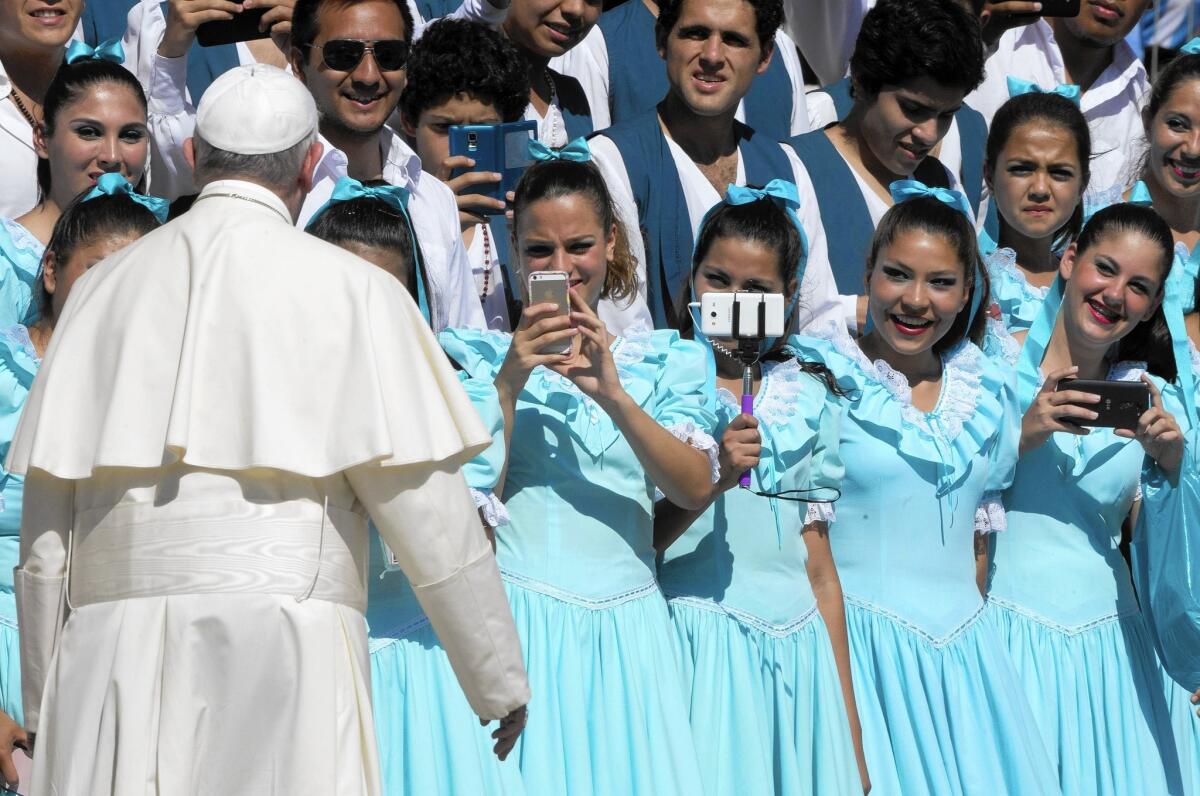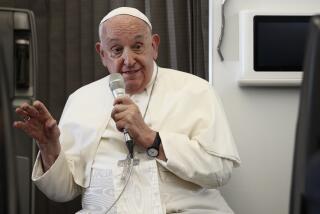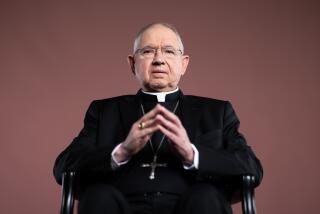Argentina remembers the future Pope Francis as a man of the people

Reporting from BUENOS AIRES — He came walking.
That’s how parishioners of Our Lady of Caacupe remember the future Pope Francis. Rather than take the archdiocese limo, Archbishop Jorge Mario Bergoglio rode a bus and then walked half a mile to the church operating out of a converted warehouse.
“Once I met him at the bus stop and offered to carry his briefcase the rest of the way, but he wouldn’t hear of it,” said Monica Morales, a church volunteer and mother of six.
Those who would understand Francis’ papacy would do well to come to this poor parish in one of Buenos Aires’ most violent, drug-infested villas, as shantytowns here are called. By doubling the number of priests and committing church resources to outreach programs, including drug abuse rehabilitation here and in other poor parishes, he reenergized its mission to serve the marginalized and vulnerable.
“Before Bergoglio, there were two churches — one of the poor and the other one being the official church,” said Father Lorenzo De Vedia, an Our Lady of Caacupe priest whom parishioners address simply as Toto.
De Vedia recalled the future pope while sitting in his cramped parish hall office, built with concrete blocks behind a former truck loading bay, and tucked inside what was once an industrial building.
“He was a novelty in that he promoted a closeness between the hierarchy and the barrios,” De Vedia said. “He was with us in every sense.”
NEWSLETTER: Get the day’s top headlines from Times Editor Davan Maharaj >>
From Sept. 22-27, Francis will visit Washington, New York and Philadelphia, a trip that will serve as an introduction for many of the U.S. faithful as well as non-Catholics to the 78-year-old Buenos Aires native who in 2013 became the first Latin American to ascend to the papacy.
With an engaging smile, humble persona and natural political acumen, Francis raised the Argentine Roman Catholic Church’s profile as defender of the poor and disenfranchised during his 15 years leading the Archdiocese of Buenos Aires. In his two years as pope, he has amplified that mission.
“Francis isn’t inventing anything. How you see him as pope is how he was in thought and action as archbishop of Buenos Aires,” said Sergio Rubin, a reporter for the Buenos Aires newspaper Clarin and coauthor of a biography of Francis.
Marcelo Figueroa, a theologian who has been a friend of Francis for 15 years, contrasts his roles as pope and parish priest concisely: “The only difference is now he wears white.”
“Down to earth” is how Ursalina Rios remembers Francis during his pre-pope visits to Our Lady of Caacupe. The poor parish is bordered by a printing plant, an industrial bakery and blocks of high-walled warehousing protected by concertina wire. He came to the church every Dec. 8 to help celebrate its saint day and stayed to participate in the blocks-long procession.
“We felt he was committed to us,” said Rios, as she pitched in on the parish sale of secondhand clothing.
Asked what the U.S. should expect during the papal visit, people who know him say Francis probably will address important U.S. issues by urging compassion for immigrants and decrying sexual abuse by priests. He may reiterate warnings issued during his July trip to South America that senseless consumerism is a “subtle dictatorship.”
His comments during that trip prompted conservative observers to label Francis a socialist. But Figueroa, who moderated a TV series of interreligious discussions that included then-Archbishop Bergoglio, said such claims miss the mark.
“To understand Bergoglio, you don’t read [German sociologist] Max Weber, Karl Marx or [Argentina’s late populist president] Juan Peron, but the Gospels,” Figueroa said.
Keys to the pope’s philosophy also can be found in his training as a Jesuit, an order which emphasizes “a connection between faith and good works,” said Gustavo Vera, a Buenos Aires city councilman.
Before his election, Vera headed a Buenos Aires-based civil society organization called La Alameda that fought human trafficking and workplace slavery. Archbishop Bergoglio became a staunch Alameda defender after Vera and others received threats from prostitution and trafficking gangs.
Like his model St. Francis, Bergoglio was a man of the world before his ordination at age 32, having first held jobs as a lab technician and a discotheque bouncer. At age 36 he became head of the Argentine Jesuit order.
Bergoglio also learned not to kowtow to authority, a disposition that put the archbishop at odds with Argentine leaders, including President Cristina Fernandez de Kirchner. She, along with her late husband and former President Nestor Kirchner, is said to have clashed with the future pope over government policies toward the poor.
“He never tried to ingratiate himself with those in power, unlike many who came before him,” Vera said, adding, “He never personalized his criticisms, but the government interpreted it that way.”
During his U.S. visit, Francis will undoubtedly echo themes from his time as archbishop, or as Figueroa put it, “stress the importance of love, of inclusion, of tending to the lost lambs that the world doesn’t want.”
Inclusion means the dregs of society, be they prisoners he met recently at a notorious Bolivian prison or drug addicts at Our Lady of Caacupe, where Francis took special interest in directing them to rehab programs, De Vedia said.
Rios, the Our Lady of Caacupe parishioner, remembered how, in addition to visiting on the Dec. 8 feast day, Francis would show up three or four times a year to have lunch with about 20 poor parishioners.
Then later, he would be off, walking to catch his bus.
Kraul is a special correspondent. Special correspondent Andres D’Alessandro contributed to this report.
ALSO:
New York security challenge: Pope Francis, United Nations -- and Beyonce
Pope Francis’ annulment reforms may draw divorced Catholics back to the faith
Awaiting Pope Francis’ visit, LGBT Catholics and supporters in U.S. are hopeful
More to Read
Sign up for Essential California
The most important California stories and recommendations in your inbox every morning.
You may occasionally receive promotional content from the Los Angeles Times.









